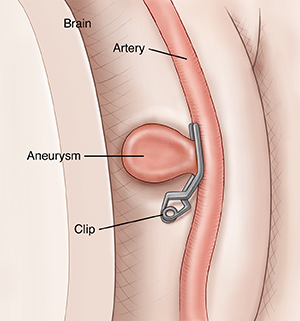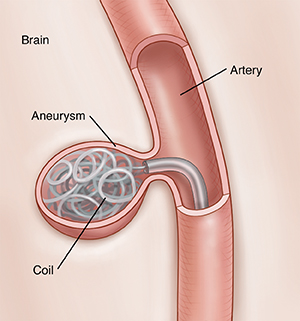Surgery for a Brain Aneurysm
A brain aneurysm is a weak spot on an artery in the brain that bulges out and fills with blood. It is also called a cerebral aneurysm. Surgery for an aneurysm is done as soon as possible if it just bled. It's often not urgent if the aneurysm hasn't bled.
If the aneurysm hasn't yet burst (ruptured), one of these 2 types of surgery is generally used:
If the aneurysm has ruptured, treatment may not reverse any damage already done. The goal is to prevent the aneurysm from bleeding or rebleeding.
Open surgery
Your surgeon reaches your brain through your skull. You'll receive sleep medicine (anesthesia) during the surgery. Your surgeon makes a scalp incision, then small holes are made in your skull. The bone between the holes is cut and lifted away. The membrane (dura) is peeled back. Trapped blood and cerebrospinal fluid (CSF) may be removed. Your surgeon closes off (clips) your aneurysm. Or the artery leading to the aneurysm is sealed off (occluded). The dura and the piece of skull are put back in place. A device that measures the pressure inside your skull or that drains your spinal fluid may be left in one of the small holes.
Clipping the aneurysm
Your surgeon may put a clip on your aneurysm where it bulges from the artery. This keeps blood from going into the aneurysm. As a result, future bleeding is stopped and nearby brain tissue is protected from more damage. Your surgeon makes sure that the clip is secure before finishing the surgery. This method is done through open surgery.

Occlusion and bypass
In some cases, it may be best to stop blood flow through the artery leading to your aneurysm. This is called occlusion. In most cases, it's done as open surgery. Sometimes occlusion is combined with a bypass. A bypass sends blood around the occlusion. It brings the blood to the part of your brain that had been fed by the damaged artery. A small blood vessel is used for the bypass.
Endovascular procedure
For many aneurysms, an endovascular procedure may be best. This is done in an X-ray lab by a specially trained healthcare provider, such as an interventional neuroradiologist, a neurosurgeon, or a neurologist. Anesthesia is given to block pain. Then a catheter is guided through the arteries from your groin to your brain. Coils are threaded into your aneurysm and a stent can be added inside the artery at the site where the aneurysm stems. The coils cause a blood clot to form in your aneurysm. This seals it off. The stent prevents the coils from backing off in the artery. This is a very effective and less risky way to treat aneurysms than open surgery. But there's a slightly greater risk that the aneurysm will reform when compared to clipping. Not all aneurysms can be treated by an endovascular approach. Newer methods are being developed. These include injecting special fluids next to the aneurysm to block it off internally and placing a mesh implant in the aneurysm.

Possible risks and complications
Risks and complications include:
-
Blood clots in the brain or stroke
-
Brain swelling or bleeding
-
The surgery can fail to stop (occlude) the aneurysm
-
Weakness, paralysis, or loss of vision
-
Confusion, loss of speech, or loss of memory
-
Infection
-
Spasm in a blood vessel that limits blood flow, which can cause you to have a stroke
-
Jerking or abnormal movements, loss of consciousness (seizures)
-
Swelling of the brain (hydrocephalus)
-
Coma
-
Death
Online Medical Reviewer:
Heather M Trevino BSN RNC
Online Medical Reviewer:
Mahammad Juber MD
Online Medical Reviewer:
Marianne Fraser MSN RN
Date Last Reviewed:
4/1/2024
© 2000-2025 The StayWell Company, LLC. All rights reserved. This information is not intended as a substitute for professional medical care. Always follow your healthcare professional's instructions.